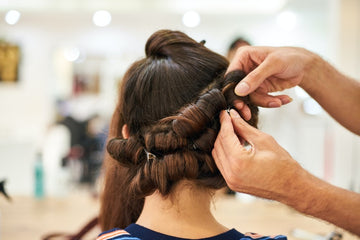The Science Behind Hair Growth
Hair growth is a fascinating process that involves various biological factors and mechanisms. To better understand it, let's delve into the science behind hair growth.
Hair Growth Cycle
The hair growth cycle consists of three main phases: anagen, catagen, and telogen. During the anagen phase, the active growth phase, hair follicles produce new hair cells at a rapid rate. The length of this phase determines the length of the hair. On average, the anagen phase lasts between 2 to 7 years.
After the anagen phase, the hair enters the catagen phase, also known as the transitional phase. During this phase, hair growth slows down as cells in the hair follicles stop dividing. This phase typically lasts for a brief period of 2 to 3 weeks.
The final phase is telogen, also known as the resting phase. In this phase, the hair follicle remains dormant for about 2 to 4 months. Eventually, the old hair shaft will fall out, and the hair growth cycle will restart with a new hair follicle.
Hair Growth Factors
Several factors influence hair growth, including genetics, age, diet, and overall health. One crucial factor is genetics – it determines the maximum potential length your hair can reach. Some individuals may find it easier to attain longer lengths, while others may struggle due to genetic factors.
Age also plays a role in hair growth. As we age, the hair growth cycle slows down, and the anagen phase shortens. This can result in thinner and slower-growing hair.
Diet and overall health are critical for maintaining healthy hair. Nutrient deficiencies, particularly those lacking in proteins, vitamins, and minerals, can impede hair growth. A balanced diet that includes foods rich in biotin, iron, zinc, and vitamin D is essential for nourishing the hair follicles and promoting optimal hair growth.
Hair Appliances and Hair Growth
Using hair appliances like straighteners and curlers does not directly affect hair growth. However, improper usage or excessive heat exposure can damage the hair shafts, leading to breakage and frizziness. Over time, frequent use of high heat can weaken the hair and cause it to appear thinner.
To minimize the risk of damage, it is crucial to use hair appliances correctly and incorporate heat protectants before styling. Additionally, it is advisable to limit the frequency of heat styling and give your hair regular breaks to recover and rejuvenate.
Promoting Healthy Hair Growth
While hair growth is primarily influenced by genetics and internal factors, there are several ways you can promote healthy hair growth:
- Maintain a balanced diet rich in essential nutrients for hair health, including proteins, biotin, iron, zinc, and vitamin D.
- Practice good hair care habits, such as regular washing, conditioning, and scalp massages to stimulate blood flow to the follicles.
- Protect your hair from excessive heat and harsh styling products by using heat protectants and avoiding tight hairstyles that cause tension on the hair shaft.
- Avoid over-washing or over-brushing your hair, as it can lead to breakage.
By adopting these lifestyle habits and caring for your hair properly, you can create an environment that supports optimal hair growth.
Conclusion
Understanding the science behind hair growth can help you make informed decisions about your hair care routine. While genetics, age, and health play significant roles in hair growth, adopting healthy habits and using hair appliances responsibly can contribute to maintaining vibrant, beautiful hair. Remember, healthy hair starts from within, so nourish your body and treat your hair with care for the best results.






